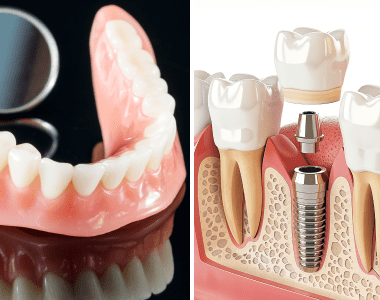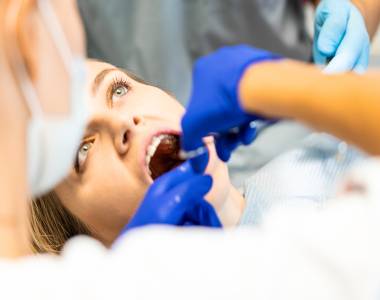
Sedation Dentistry
Sedation dentistry helps you feel calm, relaxed and at ease during dental procedures. It’s a moderate level of sedation, so you’re still technically awake but feeling very carefree. It’s sometimes called conscious sedation dentistry or “twilight sleep” because it creates a state of short-term amnesia (forgetfulness) where you experience insensitivity to pain without the loss of consciousness.
What types of sedation are used in dentistry?
There are varying levels of sedation dentistry based on your unique needs. Factors include your level of anxiety, the length of your procedure, your health history and personal preferences. The most common types of sedation dentistry include nitrous oxide, oral conscious sedation and intravenous (IV) sedation.
Nitrous oxide
Nitrous oxide is commonly known as “laughing gas.” You inhale nitrous oxide through a mask or nosepiece, and calming effects begin within three to five minutes. Your dentist controls the amount of sedation you receive and adjusts dosages accordingly throughout your procedure. Once your treatment is over, your dentist gives you pure oxygen to flush the nitrous oxide out of your system. Because the laughing gas leaves your system so quickly, you’ll be able to drive yourself home after the procedure.
Oral conscious sedation
With oral conscious sedation, your dentist gives you sedative medication (usually in pill form) about an hour before your procedure begins. Most dentists use triazolam (Halcion®), which is in the diazepam (Valium®) family. But your dentist might use other medications, too, including zaleplon and lorazepam. Dentists often used liquid sedation in pediatric dentistry, such as midazolam oral syrup.
Oral sedation makes you quite groggy, and you may even fall asleep. But you’ll still be able to communicate with your dentist if necessary, and you’ll awaken with a gentle nudge. Because oral sedation temporarily affects your memory and motor skills, you’ll need a friend or family member to drive you home after your procedure.
Intravenous (IV) sedation
IV sedation dentistry is the deepest form of conscious sedation available in a dental office setting. Your healthcare provider delivers sedative medications directly to your bloodstream through an IV line. During your procedure, your dentist monitors your heart rate blood pressure and oxygen levels. They can adjust your dosage at any point and can use reversal medications if necessary. Most people who receive IV sedation dentistry fall asleep and have little to no memory of their treatment when they wake up. This option is best for people with severe dental anxiety or those who are undergoing lengthy procedures.
What happens before sedation dentistry?
You’ll talk with your dentist about sedation options during your initial consultation. They’ll discuss your health history and ask about any medications or supplements you’re taking. Once they’ve gathered all the necessary information, they’ll make sedation recommendations based on your specific needs.
In most cases, you shouldn’t eat or drink anything for at least six hours before your dental appointment. Unless otherwise noted by your dentist, you should take all routine medications without interruption.
Be sure to tell your dentist if you’re taking any blood thinners, though, such as warfarin. They may ask you to skip these medications for a few days leading up to your procedure.
What happens during sedation dentistry?
Your dentist gives you sedative medications before beginning your procedure. You’ll still receive local anesthetic to numb your teeth and gums, but your dentist usually does this once you’re already feeling comfortable from the sedatives.
What happens after sedation dentistry?
Unless you choose nitrous oxide as your sedation option, you’ll need a trusted friend or family member to drive you home after your appointment. You should go straight home and rest while the sedative medication wears off.
What are the advantages of sedation dentistry?
Sedation dentistry eases anxieties and phobias, helping you remain calm and comfortable during dental procedures. Because your dentist can often work faster when you’re under sedation, it can result in fewer appointments. Finally, many people have so much dental anxiety that they avoid going to the dentist altogether. Sedation dentistry helps you feel more comfortable so you can receive the care you need and deserve.
Recovery time
Recovery times vary. It depends on what type of sedation you choose and how your body responds to the medications. In general, people who have nitrous oxide recover within 15 to 30 minutes and can drive themselves home following their appointment. Those who choose oral conscious sedation or IV sedation typically need about 24 hours for full recovery.
https://my.clevelandclinic.org/health/treatments/22275-sedation-dentistry

 Review Us
Review Us Review Us
Review Us 

